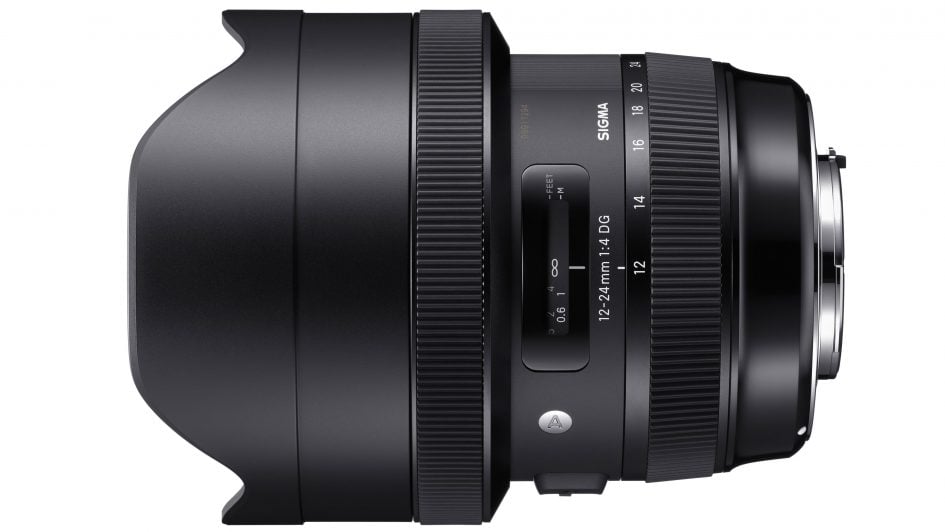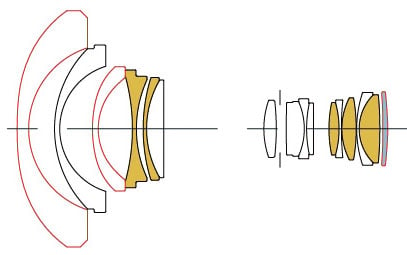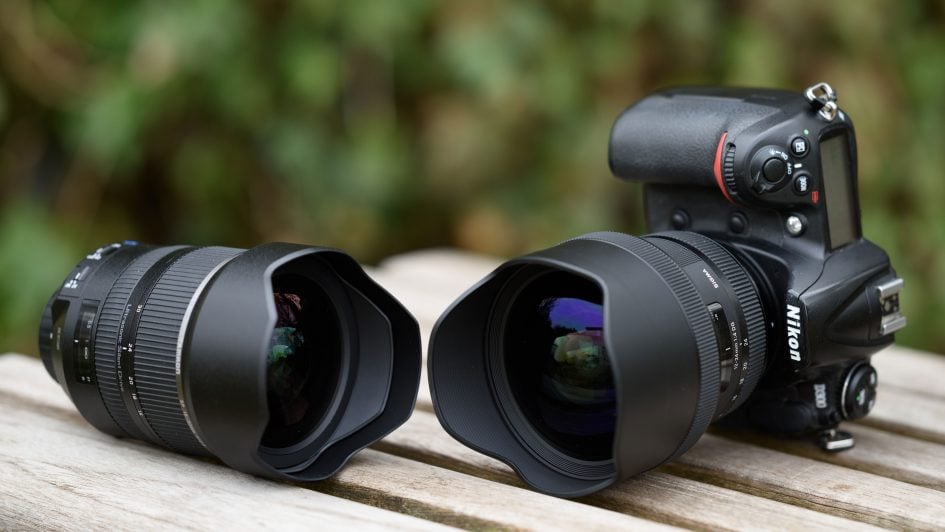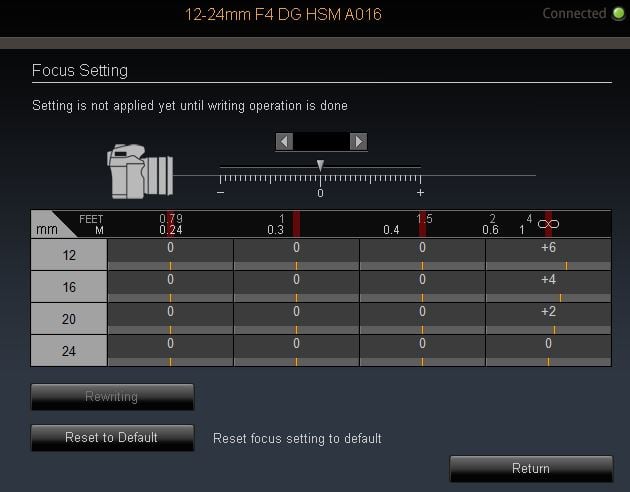Summary
 Sigma's new 12-24/4.0 soar upwards is a very competent lens: Its optical performance is up there with the reference 15-30mm zoom from Tamron, it has only minor distortions and finally offers a continual f4.0 focal ratio - although f2.8 would have been even nicer. Near importantly it goes retired to 12mm focal length offering a humongous 122 degrees lean against of purview which is only surpassed by Canon's 11-24mm f4.0 lens at almost twice the price. So although the new Sigma is not exactly cheap IT earns a Highly Recommended rating.
Sigma's new 12-24/4.0 soar upwards is a very competent lens: Its optical performance is up there with the reference 15-30mm zoom from Tamron, it has only minor distortions and finally offers a continual f4.0 focal ratio - although f2.8 would have been even nicer. Near importantly it goes retired to 12mm focal length offering a humongous 122 degrees lean against of purview which is only surpassed by Canon's 11-24mm f4.0 lens at almost twice the price. So although the new Sigma is not exactly cheap IT earns a Highly Recommended rating.
Buy out information technology now!
Check prices connected the Sigma 12-24mm f4 Graphics at Amazon, B&A;H, Adorama, or Or els get over yourself a copy of my In Camera book or treat me to a coffee! Thanks!
Sigma 12-24mm f4 Art review -
- Statute past
Deep
The Sigma 12-24mm f4.0 Artistic production is a 2x super fisheye brimfull-systema skeletale zoom available in mounts for Canon, Nikon and Sigma DSLRs. Announced in February 2017, it's already the 3rd generation 12-24mm model from Sigma. Sigma has done a complete optical redesign to nonplus a constant f/4.0 f number and improve performance fitting for cellular inclusion into Sigma's acclaimed Nontextual matter series of crest-notch lenses. Add the improved material body quality, faster AF plus compatibility with Sigma's USB-dockage to fine tune various characteristics of AF, plus if you vary bodies, use the MC-11 mount converter for Sony E-mount or pay off to take over the mount swapped for your new system and it's clear Sigma likewise wants more money for the new lens: 1600 USD/EUR is a hefty mark-prepared of 100% over the current street price of the 2nd multiplication 12-24mm 4.5-5.6 Cardinal Decigram HSM.
To find unsuccessful how the new Sigma 12-24mm f4.0 Art performs I tested information technology against my character reference lens in that segment, the Tamron 15-30mm f2.8 VC, on the demanding D810 trunk. Thus if you'ray shopping for a immoderate optical lens zoom along, you've come to the justly place!

Facts from the catalog
Arsenic customary I'll have a reckon at the specialised information first. I've rated the features with a [+] (or [++]), when it's better than average or smooth state of the art, a [0] if it's canonic or retributive average, and [-] if there's a disadvantage. I'll compare it mostly with its predecessor, the Sigma 12-24/4.5-5.6 (the "predecessor" for short) and the Tamron 15-30/2.8 VC (the "Tamron" for short). Size and weight is for the Nikon mount variation.
Size up (diameter. x distance): 102 x 130mm (4.0 x 5.1in) including the built-in lens hood. Zooming does non change the length of the lens as with its predecessor and the competition. The predecessor is small at 85 x 118mm with lens system hood. The Tamron is 98 x 143mm with the integral hood. [0]
System of weights: 1130g (39.9 oz.). The predecessor is a meager 670g and the Tamron is 1050g. [0]

Optics: 16 elements in 11 groups which is a trifle less than the 17/13 of the predecessor . The Tamron has 18 elements in 13 groups. The lens has six (unscheduled) low dispersion and trine aspherical elements. "Super-Multi-Layer" finish should reduce erupt and ghosting. [+]
Nearest focus length/max. magnification: 0.24m (0.8ft) / 1:4.9 compared to 0.28m (0.9ft) / 1:6.4 with its predecessor and 0.28 / 1:5.0 with the Tamron. The magnification of the new Sigma is quite good but you have only 6cm of working outstrip. [+]
Filter-thread: None of the ultra wide-angle zooms from Sigma, Tamron, Nikon surgery Canon offer a filter-wind. Their bulblike head-on elements forbid that. So you necessitate to get more or less non-criterial mounting system and a new put up of filters. [-]
Image Stabilization: No. Only the Tamron offers image stabilization in a camera lens zoom. [0]
Motorcar Focus on: HSM (Hyper Sonic Motor), so information technology also full treatmen on camera bodies which don't suffer an AF-drive built in like Nikon's D3x00/5×00. Extremity-focus override is by just turning the focus ring. Same with the rival. Only the new Sigma allows you to spay focus floury-tuning at four focal lengths and four distances with the USB-tail. [+]
Covers full frame/FX operating theater smaller = very good. Identical with the competition. [+]
Price: around 1600 USD / 1550 EUR (incl. 19% VAT), 100% more valuable than its predecessor which can be had for approximately 750 EUR. The Tamron currently sells for 1000 EUR. But to put the price of the new Sigma in perspective: The Nikon 14-24/2.8G is at 1800 EUR and the Canyon 11-24/4.0 L USM costs a whopping 3000 EUR. [0]
Comes with a nice padded lens display case and a strap. The lens hood is built in and cannot be far which is little practical for cleaning the bulbous front element. Another slight disadvantage is that the front lense-capital does not arrest in place when mounted: it does fit tighter than the the similar hoods from Nikon operating theatre Tamron but can work itself off when it rubs against your clothes. Samyang has shown with the 12mm f2.8 fisheye that you still can built a proper lockup mechanism for this type of lens-crownwork. Samyang also has a detachable lens shade which makes it far easier to scrubbed the outmost parts of the front component. So hither is something the other manufacturers should think about. Btw.: When you use the built-in swank the shadow of the crystalline lens toughie is prominently visible at the bottom of the prototype at any focal length. [0]
Distance info is relayed to the camera, and then the Nikon dead body can serve all the advanced exposure-related stuff with this crystalline lens. Synoptical with the competition. [+]
Aperture ring: nobelium. Same as with all the other alternatives. [0]
Waterproofing: A rubber eraser grommet at the lens-mount. [+]
The make in the "features-department" is 1[-]/6[0]/6[+]. This is quite good. Technically the only real downside is the missing filter-thread. And a minute surprising is the price: It's twice American Samoa expensive Eastern Samoa its predecessor and also costs 60% much than the Tamron which offers a constant f2.8 aperture plus image stabilization. But the lens is inactive cheaper than the alternatives from Nikon operating theatre Canon. Size and weight might fall as a shock to someone used to smaller lenses. But it is par for the course for a ultramodern ultra wide-angle zoom.
Here is the tip of view that the Sigma covers with its 2x soar:

Above: Sigma 12-24/4.0 Art coverage on Nikon D810 (FF/FX) body at 12mm (leftover), at 24mm (right)
Following is the coverage of the Tamron 15-30mm zoom. This is what the missing 3mm at the short end and the additional 6mm at the long end look like:

Above: Tamron 15-30/2.8 VC coverage on Nikon D810 (FF/FX) body at 15mm (left), at 30mm (right)
Alternatives
- Nikon has the 14-24mm f2.8G Erectile dysfunction. It got a Highly Advisable in 2013 and costs around 1900 USD / 1800 EUR. See my Nikon 14-24mm f2.8G review.
- From Sigma there's even their 12-24mm f4.5-5.6 II DG HSM for around 950 USD / 750 EUR as long as supply lasts.
- Canon has the Canyon EF 11-24mm f4.0 L USM from 2015 which is the World's widest rectilinear full-frame surg with a street price around 2700 USD / 3000 EUR. IT earned a Highly Recommended in Gordon's Canon EF 11-24mm f4L USM review.
- Tamron offers the only stabilized zoom in this radical: the Tamron 15-30mm f2.8 Di VC USD for near 1200 USD / 1000 EUR. IT earned a Highly Recommended in my Tamron 15-30/2.8 VC look back.

Above socialist: Tamron 15-30/2.8 VC, above right: Sigma 12-24/4.0 Art
Focus
Focus truth and repeatability is critical to consistently produce sharp shots. Repeatability (the accuracy of revolve around the same subject after repeated focus-acquisition) of this electron lens is very good (measured 99.1% in Reikan FoCal) with no outliers over a series of 40 shots under strictly controlled test conditions. And there is almost no performance variation whether the lens focuses from infinity or from a closer distance. Under real-life shooting conditions the lens behaved a routine dodgy at the short destruction with target distances of 10m and on the far side: In a phone number of cases the crystalline lens focused too close in form-detect AF which did non immediately establish up in the center of the prototype because of the large dof at 12mm and f4.0. But the outer areas became visibly less sharp in these cases. Arsenic in-camera AF fine-tuning was perfect for the longer focal lengths I had to depend on the USB-dock to make specific adjustments for 12mm. I'd rather wish that the lens came by rights adjusted right out of the box.

Supra: Sigma Optimization In favor of software allows AF all right-tuning for 16 different combinations of outstrip and focal length.
At 24mm focal length the lens focuses without hunting in around 0.6 sec from infinity to 0.24m, which is quite imperviable. The pore ring has atomic number 102 slow/play between its movement and the focus-action and a throw of 130 degrees which is more than enough for extremity focus at f4.0. Its rubberized surface is 12mm wide and send away be turned with ace finger. The zoom ring turns through and through 80 degrees and has a 13mm wide rubber superficial which is pretty small for the to the highest degree fundamental ring connected this lens. It's also quite an blind drunk, at the least fresh from the factory. Both rings turn in the same direction American Samoa Canon users are used to and Sigma did also put the direction phone at the front and the zoom ring very close to the camera body. So the handling is same to e.g. the Canyon EF 11-24mm 4.0 L USM. But this bequeath not delight Nikon users as they expect both rings to turn the opposite way approximately. Personally I also would have preferred the zoom ring to be foster away from the body: I occasionally got my thumb stuck betwixt the zoom along ring and the flash protruding from the consistency when turning the zoom ring from 24mm towards shorter focal lengths. On that point is simply not much clearance between the tv camera body and the zoom ring.
AF-operation is jolly quiet from the open-air, and if you record video recording with the intrinsical microphone the AF-drive produces a slight hiss but there are No clicks at the start operating room stopover of focus-movements. Real good!
Pages: 1 2 3 4
Sigma 12-24mm f4 Art review
Source: https://www.cameralabs.com/sigma-12-24mm-f4-art-review/

0 Komentar